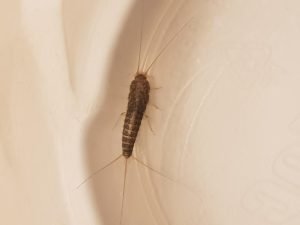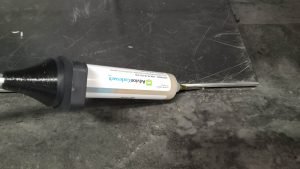The silverfish (Ctenolepisma longicaudatum) has become well established in Norway in recent years, and the number of extinctions has increased significantly.
They are also found in modern buildings. They resemble silverfish, are large, hairy and have long tails with filaments. Long-tailed silverfish are wingless insects with dark gray scales that let them shine like silverfish. They are annoying, but cause hardly any damage to houses. Long-tailed silverfish can be combated with poison baits.

The body shape resembles that of a normal silverfish. The head has two long antennae and two short maxillary buttons. At the end of a flattened, elongated and tapering back of the body are three long filaments. The middle one is directed forward and the lateral filaments are aligned laterally. The typical body length of an adult is 10-14 mm, but with antenna threads they can reach up to 18 mm.
In Norway, silverfish occur indoors and can be observed all year round. Nymphs are about 2 mm long when they leave the egg. There are 14 stages of development before they grow up and become adults. Young nymphs have no scales and are lighter coloured. Silverfish are found in buildings, especially in modern apartments.
Best ways to get rid of Silverfish

They are omnivores, and small amounts of breadcrumbs, flour, leftover dead insects, dried leaves and other organic materials are sufficient to feed the population. Adult people can survive for a long time without food and eat simple materials such as paper and wallpaper.
Full development from nymph to adult probably requires varied diet The development time depends on temperature and ranges from 18 months to 3 years. Mature adults can live very long and produce up to 50 eggs per year.
Adults and nymphs are sensitive to low and high temperatures. Long-tailed silverfish thrive best in high humidity, but they can also cope with dry environments by finding space to drain water from a drain. They are nocturnal and detect light without turning on.
Under normal conditions, long-tailed silverfish cause minimal material damage. However, they are considered a pest, and many find them annoying. Development activity is impeded at temperatures below 16 degrees Celsius and can be stopped at 11 degrees. Objects, stamp collections, cotton, linen, other plant materials and old books in museums, can be destroyed if the fish are allowed to develop.
Museums, historical collections and libraries must be vigilant. Long-tailed silverfish are difficult to eradicate. The number of individuals must be kept in check by the use of poison bait and other measures, as individuals can reproduce without doing so. In many cases, a small number of long-tailed silverfish can tolerate for a specific time.
Key players in the retail sector must assume social responsibility and, if necessary, carry out regular inspections and removal with poison bait. Storage, rental parcel terminals, bonded warehouses, postal freight, retail warehouses, second-hand stores and flea markets all play a role through distribution, and they operate where large goods flow to customers through interim warehouses and distribution warehouses.
Silverfish tails can hide in handbags and bags at work, in schools, kindergartens and private homes, where they are passive during the day and the risk of being exported to uninvited guests or infested buildings is low. They hang from elevators, pallets, boxes and furniture and establish themselves in new places to multiply and spread.
The detection of a suspected case of long-tailed silverfish is confirmed by species identification
Bathrooms, kitchens and washrooms are the best places for long-tailed silverfish. They can hide in skirts, boards, sockets, doorsills, recesses, boxes, lamps, cables and pipes.
Set traps in the best places around the building to get an overview of the situation. Set up small adhesive traps for a few weeks to capture individuals for species identification.
The silverfish will settle wherever they can spread. They are small and flat, wandering freely through a room and squeezing through tiny crevices used for plumbing, air ducts, cable ducts and paths. Joint seals in pipes, cables and ducts should be added, as should a fine mesh mesh over vents, where they will find it harder to find favourable conditions for shelter.
Integrated pest management (IPM) eradication can combine several control methods to solve the problem. Adapting the strategy to the environment is the most important method, using poison bait. The use of glue traps, temperature and environmental regulations can also be supplemented.
The removal of individuals is difficult to maintain, as their ability to spread allows the introduction of new individuals, and their hidden lifestyles mean that small residual populations cannot be detected.
Also read: Advantages Of Local Pest Control Service
Several bait products were used to fight insects in buildings. Bait is preferred to pesticides and has been shown to provide effective control in apartment buildings, office buildings, libraries, private homes and even kindergartens. Tiny amounts of poison can be used in a controlled manner.
Baits containing the active ingredient indoxacarb are the most efficient. Laboratory studies have shown that for Pest control baits have good effects and others have limited effects, so it is important to choose the right product.
An important explanation for this efficient control is the high level of secondary poisoning. Silver fish are killed when the bait contains a sufficient amount of toxin to kill all individuals who feed on the dead.
The density of one drop per square metre is a good starting point for treatment. Place the bait in small droplets of 10-20 mg droplets at the treatment site or in several places along the walls of a room or building. Many small drops of 10 to 20 mg can be placed on skirting boards with small gaps, which contributes to an effective treatment. Place the bait, for example, in a place that is far from everything else.
As insects are expected to move in search of food. Placing baits in potential hiding places increases the likelihood that insects will find and eat bait within reach of residents and pets. Make sure that baits are not accidentally swallowed, especially in kindergartens and dormitories with young children.
Remember that long-tailed silverfish can spread throughout the building and, if possible, relapse in untreated parts of the building. It is probable that the use of bait to eliminate competing food sources without thorough siphoning causes more food poisoning than the fish and exterminates them from many buildings. It may take some time for the bait to be eaten, and further treatment may be required.
The best approach is a systematic and coordinated approach to handling entire buildings. Cleaning and environmental changes, as well as good cleaning practices can restrict access to food for the long-tailed silverfish, limit population growth and improve the effectiveness of poison baits.
Vacuuming and dry wiping are best when the local humidity is limited and potential food sources such as crumbs, leftovers and the like are removed. Dry conditions give long-tailed silverfish fewer opportunities to reproduce, and buildings with low temperatures extend their development time.
Avoid spraying in environments where a high risk of exposure to users or residents is present such as kindergartens, school dining rooms, kitchens, offices, bedrooms, hospitals and other health facilities. Repeated spraying carries the risk of chronic exposure to users and buildings, which may allow the development of resistance to silverfish.
Pesticides should only be used as a small part of the IPM solution. Resistance to pesticides should be chosen for products that are least toxic to humans.
